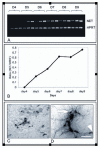Norepinephrine transport-mediated gene expression in noradrenergic neurogenesis
- PMID: 19356247
- PMCID: PMC2679758
- DOI: 10.1186/1471-2164-10-151
Norepinephrine transport-mediated gene expression in noradrenergic neurogenesis
Abstract
Background: We have identified a differential gene expression profile in neural crest stem cells that is due to deletion of the norepinephrine transporter (NET) gene. NET is the target of psychotropic substances, such as tricyclic antidepressants and the drug of abuse, cocaine. NET mutations have been implicated in depression, anxiety, orthostatic intolerance and attention deficit hyperactivity disorder (ADHD). NET function in adult noradrenergic neurons of the peripheral and central nervous systems is to internalize norepinephrine from the synaptic cleft. By contrast, during embryogenesis norepinephrine (NE) transport promotes differentiation of neural crest stem cells and locus ceruleus progenitors into noradrenergic neurons, whereas NET inhibitors block noradrenergic differentiation. While the structure of NET und the regulation of NET function are well described, little is known about downstream target genes of norepinephrine (NE) transport.
Results: We have prepared gene expression profiles of in vitro differentiating wild type and norepinephrine transporter-deficient (NETKO) mouse neural crest cells using long serial analysis of gene expression (LongSAGE). Comparison analyses have identified a number of important differentially expressed genes, including genes relevant to neural crest formation, noradrenergic neuron differentiation and the phenotype of NETKO mice. Examples of differentially expressed genes that affect noradrenergic cell differentiation include genes in the bone morphogenetic protein (BMP) signaling pathway, the Phox2b binding partner Tlx2, the ubiquitin ligase Praja2, and the inhibitor of Notch signaling, Numbl. Differentially expressed genes that are likely to contribute to the NETKO phenotype include dopamine-beta-hydroxylase (Dbh), tyrosine hydroxylase (Th), the peptide transmitter 'cocaine and amphetamine regulated transcript' (Cart), and the serotonin receptor subunit Htr3a. Real-time PCR confirmed differential expression of key genes not only in neural crest cells, but also in the adult superior cervical ganglion and locus ceruleus. In addition to known genes we have identified novel differentially expressed genes and thus provide a valuable database for future studies.
Conclusion: Loss of NET function during embryonic development in the mouse deregulates signaling pathways that are critically involved in neural crest formation and noradrenergic cell differentiation. The data further suggest deregulation of signaling pathways in the development and/or function of the NET-deficient peripheral, central and enteric nervous systems.
Figures



Similar articles
-
Norepinephrine transporter expression and function in noradrenergic cell differentiation.Mol Cell Biochem. 2000 Sep;212(1-2):61-70. Mol Cell Biochem. 2000. PMID: 11108137
-
Dependence of serotonergic and other nonadrenergic enteric neurons on norepinephrine transporter expression.J Neurosci. 2010 Dec 8;30(49):16730-40. doi: 10.1523/JNEUROSCI.2276-10.2010. J Neurosci. 2010. PMID: 21148012 Free PMC article.
-
HoxB8 in noradrenergic specification and differentiation of the autonomic nervous system.Dev Biol. 2012 Mar 1;363(1):219-33. doi: 10.1016/j.ydbio.2011.12.026. Epub 2011 Dec 24. Dev Biol. 2012. PMID: 22236961
-
The development of the noradrenergic transmitter phenotype in postganglionic sympathetic neurons.Neurochem Res. 1996 Jul;21(7):823-9. doi: 10.1007/BF02532306. Neurochem Res. 1996. PMID: 8873087 Review.
-
Molecular microfluorometry: converting arbitrary fluorescence units into absolute molecular concentrations to study binding kinetics and stoichiometry in transporters.Handb Exp Pharmacol. 2006;(175):23-57. doi: 10.1007/3-540-29784-7_2. Handb Exp Pharmacol. 2006. PMID: 16722229 Review.
Cited by
-
18F-meta-fluorobenzylguanidine (18F-mFBG) to monitor changes in norepinephrine transporter expression in response to therapeutic intervention in neuroblastoma models.Sci Rep. 2020 Dec 1;10(1):20918. doi: 10.1038/s41598-020-77788-3. Sci Rep. 2020. PMID: 33262374 Free PMC article.
-
The Central Noradrenergic System in Neurodevelopmental Disorders: Merging Experimental and Clinical Evidence.Int J Mol Sci. 2023 Mar 18;24(6):5805. doi: 10.3390/ijms24065805. Int J Mol Sci. 2023. PMID: 36982879 Free PMC article. Review.
-
Enhanced tyrosine hydroxylase activity induces oxidative stress, causes accumulation of autotoxic catecholamine metabolites, and augments amphetamine effects in vivo.J Neurochem. 2021 Aug;158(4):960-979. doi: 10.1111/jnc.15432. Epub 2021 Jun 12. J Neurochem. 2021. PMID: 33991113 Free PMC article.
-
Methylphenidate and cocaine self-administration produce distinct dopamine terminal alterations.Addict Biol. 2014 Mar;19(2):145-55. doi: 10.1111/j.1369-1600.2012.00456.x. Epub 2012 Mar 28. Addict Biol. 2014. PMID: 22458761 Free PMC article.
-
Altered reward circuitry in the norepinephrine transporter knockout mouse.PLoS One. 2013;8(3):e57597. doi: 10.1371/journal.pone.0057597. Epub 2013 Mar 4. PLoS One. 2013. PMID: 23469209 Free PMC article.
References
-
- Fritz JD, Jayanthi LD, Thoreson MA, Blakely RD. Cloning and chromosomal mapping of the murine norepinephrine transporter. J Neurochem. 1998;70:2241–51. - PubMed
Publication types
MeSH terms
Substances
Grants and funding
LinkOut - more resources
Full Text Sources
Molecular Biology Databases
Miscellaneous

